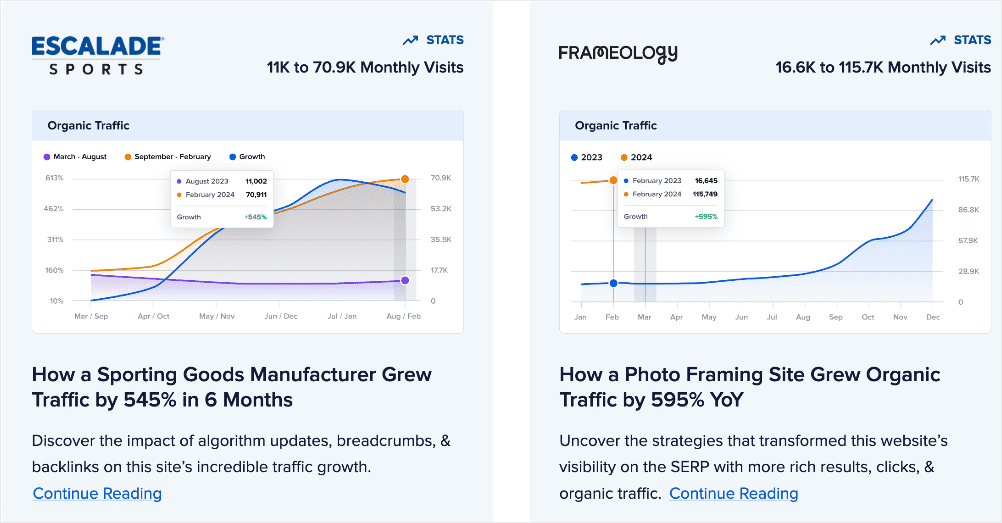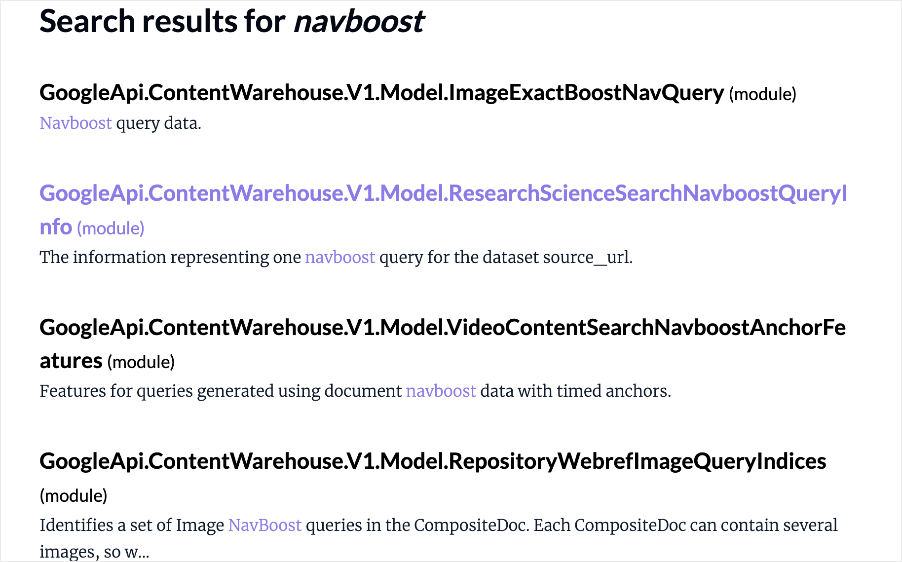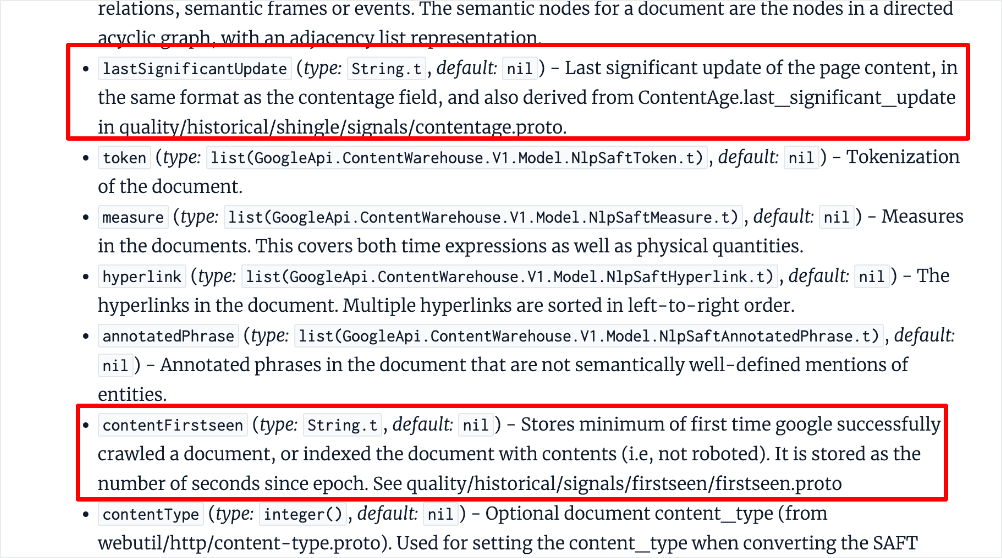[ad_1]
You’ve probably heard all the noise of the Google search algorithm leak and are wondering what it’s all about.
While some may caution against digging deep into the data, the truth is that SEO is a data-driven discipline. The insights provided by the leak, no matter how small, have a huge bearing on how we approach search marketing.
But, with so much jargon and technical lingo used in the leaked documents, how can the average solo marketer leverage the data leak?
This article delves into the implications of the Google Search Algorithm leak and how DIY SEOs can leverage this newfound knowledge to enhance their search rankings.
What is the Google Search Algorithm Leak?
In May 2024, over 2,500 pages of Google’s internal search algorithm documentation were inadvertently leaked. A search marketer named Erfan Amizi discovered this and brought it to Rand Fishkin and Mike King’s attention.
The leak revealed details about the Content Warehouse API, a potential core part of Google’s ranking system. You can find the leaked doc here.
These leaked documents reveal over 14,000 ranking factors and give an unprecedented look into Google’s methods for ranking websites. This leak has clarified many speculated aspects of Google’s algorithms and introduced new concepts previously unknown to the public.
This is why this is the biggest thing to happen in search in decades.
The leak offers a glimpse behind Google’s curtain and unveils how the search engine giant’s search algorithm works. This gives SEOs valuable insights they can use to better strategize for better rankings and increase the traffic to their sites.
Whether you’re a seasoned professional or a DIY enthusiast, understanding these revelations can empower you to create a more effective SEO strategy.
Why Serious SEOs Care About the Google Search Algorithm Leak (And You Should Too!)
As said, the leak revealed details about Google’s Content Warehouse API, a core part of Google’s ranking system. This shed light on several key areas:
Confirmation of Best Practices
The leak confirms many of the best practices that SEO professionals have advocated for years, such as:
- Producing high-quality content
- Building authoritative backlinks
- Optimizing for user experience.
This validation helps prioritize SEO strategies that are known to align with Google’s ranking factors.
New Ranking Factors
Previously unknown ranking factors, such as the “siteAuthority” score and the role of Chrome user data, have come to light. Understanding these factors can help SEOs fine-tune their strategies to better align with Google’s criteria.
Helps Paint a Clear Roadmap for SEO
The detailed documentation offers a roadmap for future SEO efforts, highlighting the importance of user engagement metrics, content freshness, and expert-authored content. This roadmap can guide SEOs in creating more effective, long-term strategies.
Internal Lingo
The leak introduces specific terminologies used internally by Google, such as “Navboost” and “Golden Documents.” Understanding these terms can help SEOs ask more direct and informed questions to Google representatives, leading to better communication and clearer insights.
9 Major Takeaways From the Google Search Algorithm Leak
We need to note that the insights in the leaked Google search algorithm document don’t paint the full picture of how Google ranks pages. Some of the features mentioned are also experimental and some no longer in use.
So, while the document contains valuable information, not all of it is practical for SEO.
In this section, I’ll walk you through some of the most important findings in the doc. Don’t worry. I won’t use the technical jargon used in the document and by many analysts. Instead, I’ll decode the findings into layman’s terms so you get actionable insights you can use to boost your search rankings.
1. Google is Not Always Never Transparent: Experimenting is Key
One of the most important findings from the Google search algorithm leak is that Google isn’t transparent about what really goes on under the search engine’s hood. While many fault the search engine giant for this, remember, every business needs to keep it’s secret sauce a secret. Besides making financial sense, it also helps keep malicious actors from gaming the system.
Some of the most prominent untruths by Google uncovered in the leak include:
- The value of backlinks
- A site’s authority matters
- Toxic backlinks exist
What to Do ➡️:
Because Google isn’t outright about many of the criteria it uses in its ranking algorithm, most people speculate.
But there’s a better way.
SEO is not a guessing game. Success relies on aligning your strategies with Google’s ranking signals. However, it may seem impossible, with many of them shrouded in mystery. But it’s not. You can run experiments to help see which strategies work.
Besides running experiments, you look at data from other brands crushing it at SEO. This is one reason we started our SEO Trends section. These are case studies highlighting the winning strategies some of our customers have used to boost rankings and traffic.

Finally, with the data leaked in Google’s search algorithm document, you can experiment on some of the practical high-value ranking factors. You can assign each a score and see which brings the most returns to your rankings.
2. Navboost is One of the Most Important Ranking Signals
One of the most significant revelations from the Google search algorithm leak is that Google actually tracks and uses clicks as a ranking signal. This is done through a feature internally called Navboost.
Navboost is one of Google’s top-ranking signals. It is mentioned 84 times in the document.


It was also mentioned about 54 times by Pandu Nayak in the October 2023 DOJ anti-trust hearing.
So, what is Navboost all about?
In essence, Navboost is a function that helps Google track and use engagement signals to rank pages. It shows that Google heavily relies on user interaction data, such as click metrics, to rank pages. Different types of clicks (e.g., good, bad, long) play a crucial role in determining a page’s ranking.
Remember, this is something many of Google’s spokespersons denied.
According to the leaked document and testimony from the DOJ trial, Navboost is real and weighs heavily on how pages are ranked.
Most SEOs have viewed click data merely as a result of good rankings. But according to Navboost, click data is also used as a diagnostic tool that helps search engines weigh different pages for ranking. This new revelation is crucial for SEOs to help them design more efficient campaigns.
What to Do ➡️:
Integrate CRO into Your SEO
Because clicks matter, one of the most important things you can do in this regard is to include conversion rate optimization (CRO) in your SEO strategy. This will help encourage organic clicks on SERPs.
Use Internal Links to Boost Engagement
Another strategy you can use is building strategic internal links. Remember, it’s not only the links on SERPs that Google tracks. They also track engagement with your pages, and internal links help boost engagement metrics like clicks, dwell time, page views, and more.
3. Links are Still Important Ranking Factors, But…
Links remain a cornerstone of Google’s ranking algorithm. The diversity and relevance of backlinks, as well as mentions of entities, significantly impact rankings. However, this is only if you build quality and relevant links. Additionally, mentions of entities still seem to be a factor in how Google views your website’s authority.
Surprisingly, however, the document says Google doesn’t put any value on outbound external links. In fact, all mentions of linking out are made in a negative light.
What to Do ➡️:
- Create cornerstone content and topic clusters
- Build relevant backlinks
- Build up your entity SEO
Links have always been the backbone of the internet, and they always will be. However, the way you build your internal links and backlinks should be more strategic. This will help you get the most out of your link building efforts.
Thankfully, there are many internal link building tools that can help you build internal links more efficiently. The same applies to backlinks.
Note: AIOSEO has a powerful internal link-building module called Link Assistant. It crawls your site and offers link suggestions for related content.
4. High-quality Content Matters
While this is no secret, the value of high-quality content was also highlighted in the leaked document. Of particular note are 2 factors:
Content freshness
Google emphasizes freshness of content, with updated and timely information receiving higher rankings. It evaluates the date of content through various methods, including byline dates, URL dates, when the page was last updated, and more.


Google E-E-A-T
Google started emphasizing E-E-A-T signals a couple of years ago, and continues to be an essential factor. This time, there’s a huge thrust on expert and authoritative authors.
Content is the backbone of the internet, and as such, engines want to ensure they serve users the best. This is why content quality will always be essential in creating SEO content that ranks.
What to Do ➡️:
Content Optimization
One of the first steps to ensure your content is of high quality is content optimization. This goes beyond avoiding keyword stuffing and thin content. It also involves meeting search intent, proper linking, and more. You can leverage various content optimization tools for this. Great examples include SEOBoost, Clearscope, and others.
Combat Content Decay
Content decay is the gradual loss in rankings and traffic of a piece of content. This can be impacted by content being stale. And as can be alluded from the leaked doc, it can also be a result of a piece of content not getting clicks. Also, when you update a piece of content, make sure all dates associated with the freshness of the content are accurate (in schema, sitemaps, etc.)
Implement E-E-A-T
Google cares who the authors of your pages are. This means more weight should be put in demonstrating E-E-A-T signals than ever before. One way of this is paying closer attention to author SEO. If possible, use writers with many citations cross the web as that also carries weight.
Note: AIOSEO’s Author SEO module was designed specifically to help site owners demonstrate E-E-A-T signals.
5. Chrome User Data Plays a Huge Role in Ranking
Another shocking revelation from the leaked document is that Google uses data from its Chrome browser as part of the search experience. This means that despite denying it, user behavior in Chrome affects search rankings.


How does this impact SEO?
This means the way users land on your site, how they interact with it, and where they go after leaving could have a bearing on the value placed on that page. If users bounce off your page and go to another search result and spend more time there, that listing could be ranked higher than your page.
What to Do ➡️:
Use clickstream data from tools like SimilarWeb and Semrush Trends to get an overview of how visitors arrive at, interact with, and exit your site. This helps you understand what people are looking for, thereby equipping you to give them that information. As a result, they won’t be so quick to leave your site.
You can also use tools like Microsoft Clarity to see how users interact with your site.
Also, invest in a positive user experience (UX) for users once they’re on your site. For example, optimize for speed, performance, readability, and more.
6. Human Quality Raters Have a Hand in Ranking
The role of human quality raters in evaluating and labeling content has been underscored. Their role is to rigorously assess the top search results using the criteria outlined in these guidelines. They offer insights that enable Google to continuously refine and optimize its search algorithms.
For example, these raters influence the ranking of certain documents, marking them as “Golden Documents” for higher weight in rankings. They also help train classifiers to better categorize web pages.
For more insight, check out Cyrus Shepherd’s experience as a Quality Rater.
What to Do ➡️:
Create content that quality raters would score as high quality so your content has a small influence over the next core update. Don’t fall into the error of thinking SEO is all about gaming search engines. Those days are long gone.
7. SiteAuthority is a Thing
This is one aspect in which people like Rand Fishkin of Moz probably feel the most vindicated. That’s because for a long time Google denied they ever used anything that closely resembles domain or site authority.
But the cat’s out of the bag on this one:


Google uses a “siteAuthority” score to rank websites, contradicting previous public statements denying such a metric.
What to Do ➡️:
While the scoring system isn’t determined, a few factors are known to indicate a site’s authority. A few examples include:
Build a Strong Brand
Build a strong brand and encourage mentions of your brand on all digital platforms. This signals to Google that users trust and value your brand. It also makes it easy to associate relevant entities to your brand. Both lead to better search rankings.
Backlinks
These are links from other sites to yours and usually count as a vote of confidence in the quality and trustworthiness of your site and content. Building relevant backlinks can help boost your authority. However, be careful who you get backlinks from, as the leaked document also shows that Google does believe in toxic backlinks.
Content/Topic Clusters
Topic clusters are interlinked articles that comprehensively cover a subject from many angles. They significantly impact building your authority in your niche or industry.
8. The Sandbox Confirmed
It has long been speculated that new sites are monitored in a “sandbox” to prevent manipulation and ensure quality. This sandbox period can limit the visibility of new sites temporarily.
Again, Google has been denying this all along. But the Google search algorithm leak shows otherwise.


The leaked document shows that Google has an attribute called “hostAge” and is used to limit new sites until they’re deemed trustworthy. This means if you’re starting a new blog, you can expect it to be stagnant until it can be trusted.
What to Do ➡️:
New websites are monitored in a “sandbox” to prevent manipulation and ensure only quality sites are promoted. To help your new site come out faster:
- Boost E-E-A-T signals
- Create high-quality content
- Use channels like Social media, push notifications, and email to drive traffic
You can also check out our guide on doing SEO for a new site to get more information.
9. Special Treatment is Given to Critical Content
Another not-so-surprising find in the Google search algorithm document was that specific types of content receive special treatment. For example, content related to elections and COVID-19 receives special treatment through whitelists to ensure reliable information is prioritized during critical events.
What to Do ➡️:
Always publish factual and reliable information, especially if you’re in a sensitive industry (e.g, health, finance, governance and law).
The Google Search Algorithm Leak: Your FAQs Answered
What was leaked?
Thousands of internal Google documents related to their search engine ranking factors were leaked online in May 2024. This leak offered a glimpse into the Content Warehouse API, a potential core part of Google’s search algorithm.
What does the leak reveal?
The leak details over 14,000 attributes Google might consider when ranking a search result. This includes factors like content quality, user engagement metrics, backlinks (potentially), and the author’s expertise.
How did Google respond to the leak?
Google cautioned against drawing conclusions from the leaked documents, emphasizing that the information might be out of context, outdated, or incomplete. They stressed that understanding the full scope of their search algorithms requires more than just the leaked documents.
What are the key takeaways from the Google Search algo leak?
Some key insights include:
- SiteAuthority: Google uses a “siteAuthority” score to rank websites.
- User Interaction Data: Various types of user interactions, such as click metrics, significantly influence page rankings.
- Content Freshness: Updated and timely content is prioritized.
- Human Quality Raters: Human evaluators play a crucial role in labeling content, which affects rankings.
- Chrome Data: Data from the Chrome browser is used in ranking decisions
But nothing sums everything up as well as this SEO expert quote from the President of AIOSEO, Benjamin Rojas:
“For years, SEOs have been speculating about how Google ranks websites. The algorithm leak has finally shed some light, but one thing is clear – producing great content that helps users should still be the top priority.
At the end of the day, if you focus on providing an excellent user experience, search engines will reward you.”
– Benjamin Rojas, President – AIOSEO
We hope this post helped you catch a glimpse of some important stuff in the Google search algorithm leak. Granted, this is just a minute portion of the treasure trove of information in the document. There’s still so much more for SEOs to explore.
You may also want to check out other articles on our blog, like our ultimate guide to WordPress SEO or our tips for avoiding SEO scams.
If you found this article helpful, then please subscribe to our YouTube Channel. You’ll find many more helpful tutorials there. You can also follow us on X (Twitter), LinkedIn, or Facebook to stay in the loop.
Disclosure: Our content is reader-supported. This means if you click on some of our links, then we may earn a commission. We only recommend products that we believe will add value to our readers.
[ad_2]


